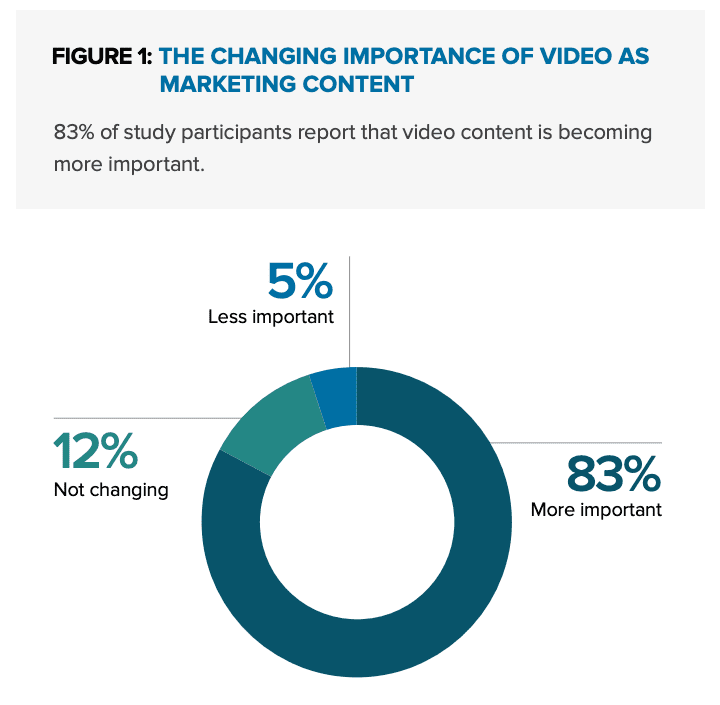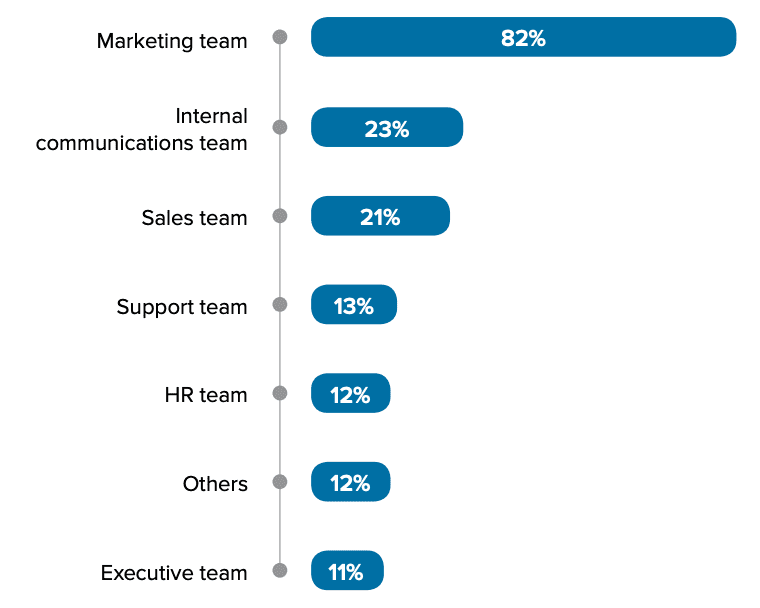Chart of the Week: Most marketers say that video content as a marketing tool is becoming more important and more are reporting greater satisfaction in its results
We all know that video content is effective and resonates well with an audience. In fact, for the fifth row in a year, marketers have said that video as a form of marketing or sales content is becoming more important.
83% of respondents to Demand Metric’s report ‘The State of Video Marketing 2018’ said that video is increasing in importance, showing that brands need to include video in their marketing strategies or risk getting left behind.
In fact, only 5% of respondents said that video as a form of marketing content is becoming less important, which could suggest that they are making use of other forms of content going forward.

How are videos used?
While websites and social media were top of the list in terms of where video content is used, with 85% and 84% of respondents using these, respectively, many marketers are using videos in different ways. Some 67% of respondents use video on YouTube, while others use them on landing pages (57%), recorded webinars (55%), emails (55%) and to help with sales conversions (24%).
Out of all of these, recorded webinars have seen the biggest year-on-year increase, with 15% more marketers making use of them. Emails using video content also saw a reasonable jump, with 9% more using them, while social media video use rose 7% compared to 2017.
As the importance of video is seen to be increasing by those within marketing, it is likely that brands will come up with more creative ways to make use of video content. While social media, YouTube and landing pages are still good places to showcase videos, looking at how you can target a larger audience with your marketing campaign can mean better ROI.
Where you’re planning on putting your videos can also inform their content, helping you to create something different that starts conversations. After all, your video is unlikely to go viral if it follows a tried and tested format that we’ve seen before.

Types of videos
When it comes to the types of videos that marketers have invested in, webinars topped the list with 56% of respondents having created them as part of a campaign. This was closely followed by demos (52%) and social media videos (51%), showing that videos are already being seen as a key tool for sales and engagement,
Other videos being invested in were explainer videos (49%), product videos (47%), customer videos (41%) and educational videos (34%).
Just 31% of marketers said they had created live streams, suggesting that brands could be missing out on making the most of Live videos on Facebook and Instagram.
In 2017, 78% of online audiences were watching Facebook Live videos, so this figure is likely to have increased over the last year. With less than a third of marketers using live streaming, there is a greater chance that your videos will be seen not only by your target audience but by a broader range of people.
Live videos can be used for a range of things, from announcing new products to influencer takeovers or showcasing your company culture. Because they can’t be edited, live videos offer your audience an authentic experience, which can be a great way to express your brand values and create content that resonates.

Video conversion
Of course, awareness isn’t the only aim of the game when it comes to video marketing, you also want your content to drive conversions. Luckily, the research found that video content is still effective at driving conversions, with 59% of respondents saying that video performs much or somewhat better than other forms of content.
Only 6% reported that video content performs somewhat worse and 1% said it performs much worse. While this is positive in that most marketers see better conversions when it comes to video content, it also shows that you are not guaranteed to get the best results.
Although the percentage of those seeing negative results is low, these findings show that not having the right video marketing strategy can cause issues, just as with other types of content.
Creating videos that aren’t informative, interesting or suited to your brand can mean you see low conversions rates. When you couple this with the often-high cost of creating video content, it shows that planning and where you show your video can make all the difference.
While most marketers are seeing better rates of conversion with videos compared to other types of content, you can’t simply assume that this will be the same for your latest marketing campaign.

Video creation
With video content being suitable and effective for such a range of marketing activities, it probably comes as no surprise that most videos are created by marketers. According to the report, 82% of videos are created by the marketing team, which is the fifth consecutive year that this has been found to be the case.
The second largest creator of video content is internal communications teams, but they only create 23% of videos, showing a huge difference compared to the marketing team. Videos are also now created by the sales team (21%), support team (13%), HR team (12%) and the executive team (11%).
It isn’t just marketing teams creating the bulk of the video content, the report found that they are also the driving force behind video creation. The fact that marketing strategy and execution fall under the remit of marketing teams, the fact that 85% of video content creation is driven by marketing teams is hardly surprising.
What is surprising, considering the fact that video is such a strong driver of sales, is that only 23% of video content creation is riven by the sales team. As there are many ways in which video can be sales-focused, this suggests a great opportunity for sales and marketing teams to join forces and create great videos that deliver results for both.

Video results satisfaction
Perhaps one of the most important findings of the report is the fact that most marketers are satisfied with the results of their video marketing campaigns. While only 5% are very satisfied with the results they see, 46% said they were satisfied.
Only 6% of respondents were either dissatisfied or very dissatisfied, which could suggest that they have not yet found the type of video content that works best for their brand.
Satisfaction with video results also has a strong correlation with the number of videos being produced. In fact, 82% of those who said they were satisfied or very satisfied with their results from video marketing create over 51 videos a year. This is 10% higher than the results from the previous report.
Low levels of satisfaction (18%) were seen among those who produce less than five videos a year, so it seems that in order to get the most out of videos, you need to create more and create a defined strategy.

Final thoughts
Essentially, all of these findings from the State of Video Marketing 2018 report point to the same conclusion – you need to be creating more video.
With the importance of video being on the rise and the results from video content improving when you create more, it goes to show that video is a worthwhile investment.
Even better, now that video marketing is so common, there are more and more cost-effective video production tools becoming available. This means that brands of all sizes can implement a video marketing strategy.
However, what is evident from the small levels of dissatisfaction with video is that not everyone is getting it right. As well as looking at the types of videos you are producing, you also need to evaluate where you are placing your video.
Not all video content is suited to social media, just as you don’t want to embed every video you create in emails. Experimenting with where you publish videos, as well as their content, can help you create the best strategy and, ultimately, lead to the best results.